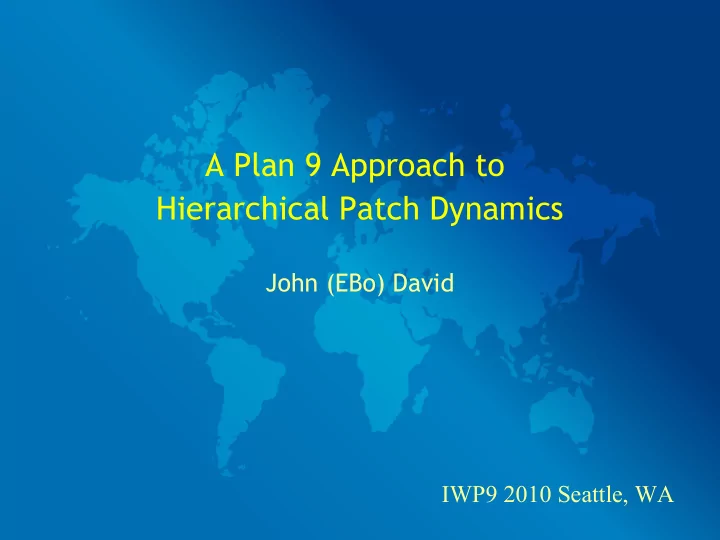

A Plan 9 Approach to Hierarchical Patch Dynamics John (EBo) David IWP9 2010 Seattle, WA
Many Problems are Inherently Multiscale Wu & David (2001)
Hierarchical Patch Dynamics (HPD) ( Wu and Loucks 1995) HPD explicitly integrates hierarchy theory with patch dynamics , and provides a conceptual and operational framework for linking pattern, process, and scale in heterogeneous landscapes. Clean model decomposition allows linking across disciplines as well as scale Fully runtime polymorphic
Hierarchy Theory (Simon 1962) Focuses on top-down constraints and driving functions Cedric Ratez, et al. (2007)
Patch Dynamics (Pickett and White 1985) • Focuses on spatial configuration and heterogeneity Sevelleta LTER
Unit-models, Transport-models and Neighborhoods Unit-models: Model a semi-closed system Know nothing about the outside world Contain state information Typed
Unit-models, Transport-models and Neighborhoods Transport-models: Used to connect two unit-models Stateless by convention Connectivity defined by neighborhood rules Directed arc defined by model types
Unit-models, Transport-models and Neighborhoods Neighborhoods: Implicit (4-cell, 8-cell) Explicit Anisotropic
Examples: Urban growth modeling with Cellular Atomata Fluvial geomorphology linked with alternative vegetation models Forest fire dynamics Run-time polymorphism
Example: Urban Growth (CA) Wu & David 2002
Example: Linking CA Braided Stream Model Vegetation Succession • UD – undisturbed UD 0 OW • 0 – recently disturbed • OW – open water GR • GR – bare gravel • H – herbaceous wetlands H SV • SV – popular/willow seedlings on gravel CY CV • CW – willow saplings • W – mature willow CM W • Cellular automata based on • CS – cottonwood/poplar with routing water and sediment • shrubs CO CS along a regular grid. • CY – young cottonwood • Lateral movement • CO – over-mature cottonwood SG accommodates bank • SG – shrubs and grassland erosion
Example: Linking CA Braided Stream Model Vegetation Succession • Cellular automata based on routing water and sediment • Plant recruitment and growth model along a regular grid. • Non-linear feedbacks to geomorphic • Lateral movement processes as a function of stand accommodates bank structure (density and basal area) erosion
Example: Fire Dynamics Anisotropic spread of fire - gray burned, black burning
Example: Run-time Polymorphism Overloading models at runtime provides mechanisms to model dynamic hierarchies Original model Conversion even cause the unit-model to be decoupled from the system Temporal transport-model data-mines old unit- model to parameterize new one New unit-model
Acknowledgments: I would like to thank Google for their Summer of Code internship which supported the start of the HPD rewrite using Plan 9 primitives. Many thanks go to my GSoC mentor Dr. Ron Minnich for all his guidance this summer.
Recommend
More recommend